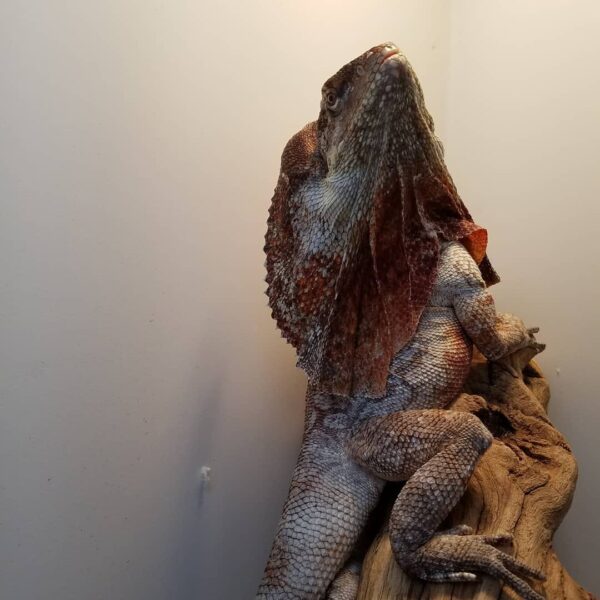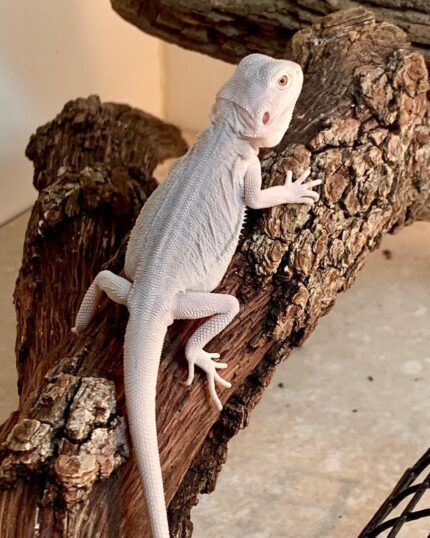Citrus bearded dragon, If you’re a big beardie fan, you might have seen the citrus bearded dragon, otherwise known as the tangerine or yellow bearded dragon. This gorgeous, boldly colored lizard is a real eye-catcher (though some can be neutral tones).
These lizards are friendly, interactive, and perfect for beginners and novice owners alike. If you appreciate this species and want to know more, we’re going to cover all the basics. Who knows—maybe the citrus beardie is your next pet?
Do Citrus Bearded Dragons Make Good Pets?
In natural habitats, bearded dragons live in grasslands and savannahs throughout Australia. Today, they are one of the most popular lizards for hobbyists the world over.
Bearded dragons are some of the friendliest lizards you can pick to have as pets. They make excellent first-time reptiles for a child, permitting that they are responsible enough to perform general care.
Because they don’t have strict environmental requirements, upkeep should be relatively easy. These are the kind of lizards you can carry around on your shirt or let out to play on the floor.
As long as you can keep up with primary care and interact with your beardie, these lizards are perfect for just about anyone.
Appearance
Citrus bearded dragons range from bright yellow to light tan. They have flat bodies with nodules and spikes along their sides, neck, and legs. Males have more pronounced femoral pores on their hindquarters—which is a distinct sex indicator.
Males typically grow larger than females with more pronounced heads, growing nearly 24 inches mature. Females only grow to be 16 to 19 inches once they reach adulthood.
How to Take Care of Citrus Bearded Dragons
Since bearded dragons are tropical creatures, they require specific living conditions to stay healthy. For example, beardies don’t produce calcium independently, so they derive these nutrients from UVB light and calcium supplementation.
Habitat, Tank Conditions & Setup
Tank
Citrus bearded dragons can grow up to 24 inches total, so their enclosure has to accommodate their size. Adult bearded dragon requires at least a 40-gallon, all-glass tank.
Beardies don’t climb as much as some other reptiles, but they do love hanging on to larger branches with firm bark. But the width of the enclosure should be more than the height.
Enclosure Decor
Even though bearded dragons are curious creatures that are highly alert, they love being lazy, too. So they spend most of their day basking in their favorite spot, flatly soaking up the rays.
But when they’re not having a tanning session, you can find them hiding in a hollow log or hide. They love piling into a dark place with a snug fit for a good nap.
You can also have beardie-safe plants and other décor just to spice things up.
Lighting
Bearded dragons need UVB light to absorb calcium and vitamin D. These lights should stay on for 12 hours per day. These lizards require no lighting at night—but you should always make sure temperatures stay above 65 degrees F.
Heating (Temperature & Humidity)
Beardies use different heat sources to regulate their body heat. They require a basking spot, which should stay between 88 and 100 degrees F. The cooler side of the tank should remain between 75 and 85 degrees F.
Humidity levels should stay between 20% to 40%. They don’t require as much moisture as some other reptiles, but proper humidity aids in shedding and overall skin health.
You can buy a thermometer and hydrometer to keep in the cage for monitoring.
Substrate
The substrate you pick is very important, as it lines your lizard’s environment.
-
Reptile carpet
-
Newspaper
-
Bare bottom
Even though sand is advertised constantly as a good substrate for beardies, this is not true. These smaller particles can digest with food, causing major intestinal blockages-which can lead to death.
Popular as pets, bearded dragons or “beardies” are moderately sized lizards native to Australia. The age groups are as follows: Hatchlings 1 month old, Well started 1-2.5 months old, Juveniles 3-6 months old, young adults 6+ months old. Whatever is on hand at the time of your order is what will be shipped. The photos used are just a reference for this morph and not the exact animal you will be receiving. Colors/patterns will vary as each animal is completely unique.
Names: Bearded dragon, Pogona vitticeps, Central bearded dragon, Inland bearded dragon
Size: 16 to 24 inches long
Lifespan: 6-10 years is common but up to 20 years is documented













Reviews
There are no reviews yet.